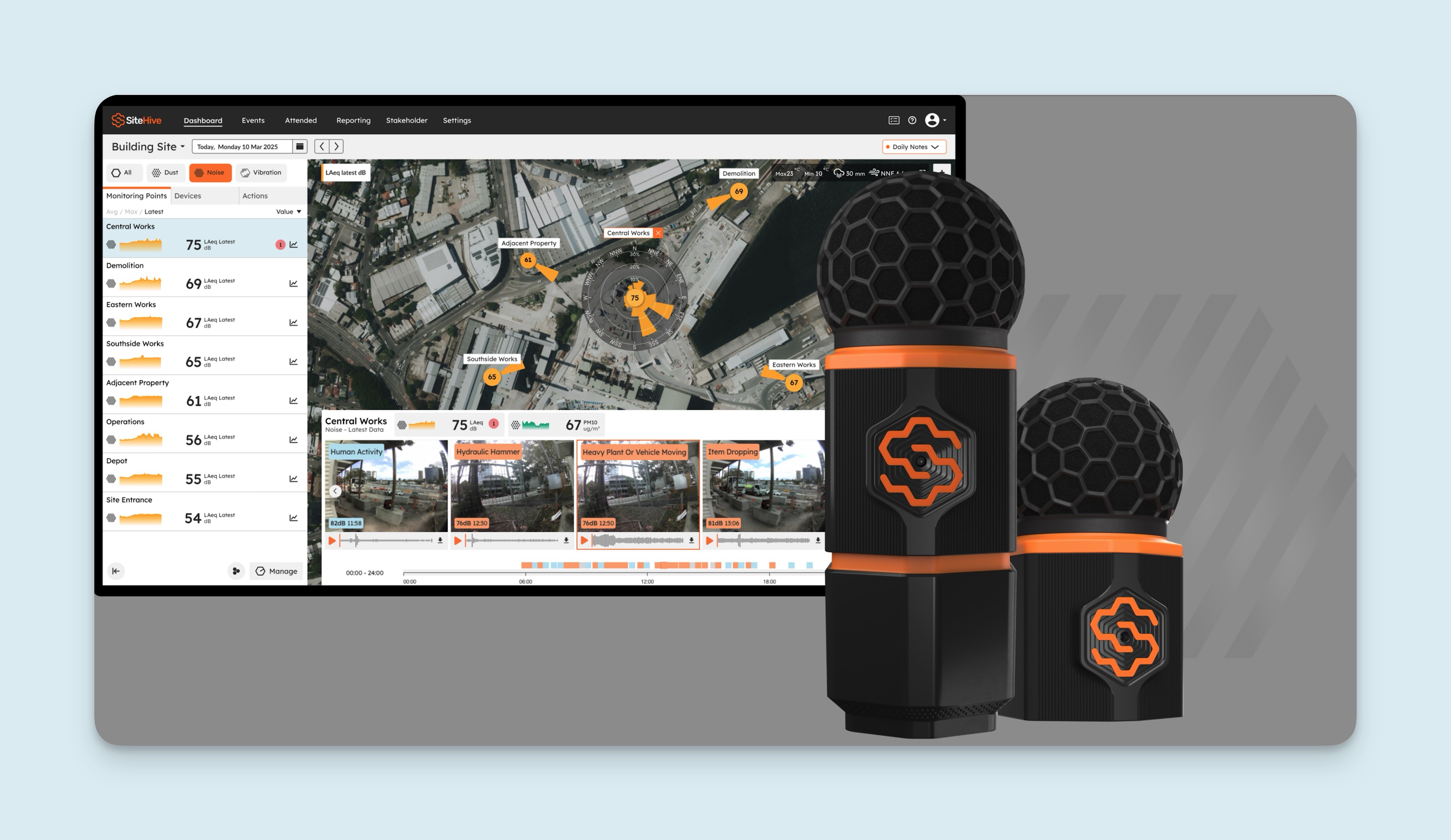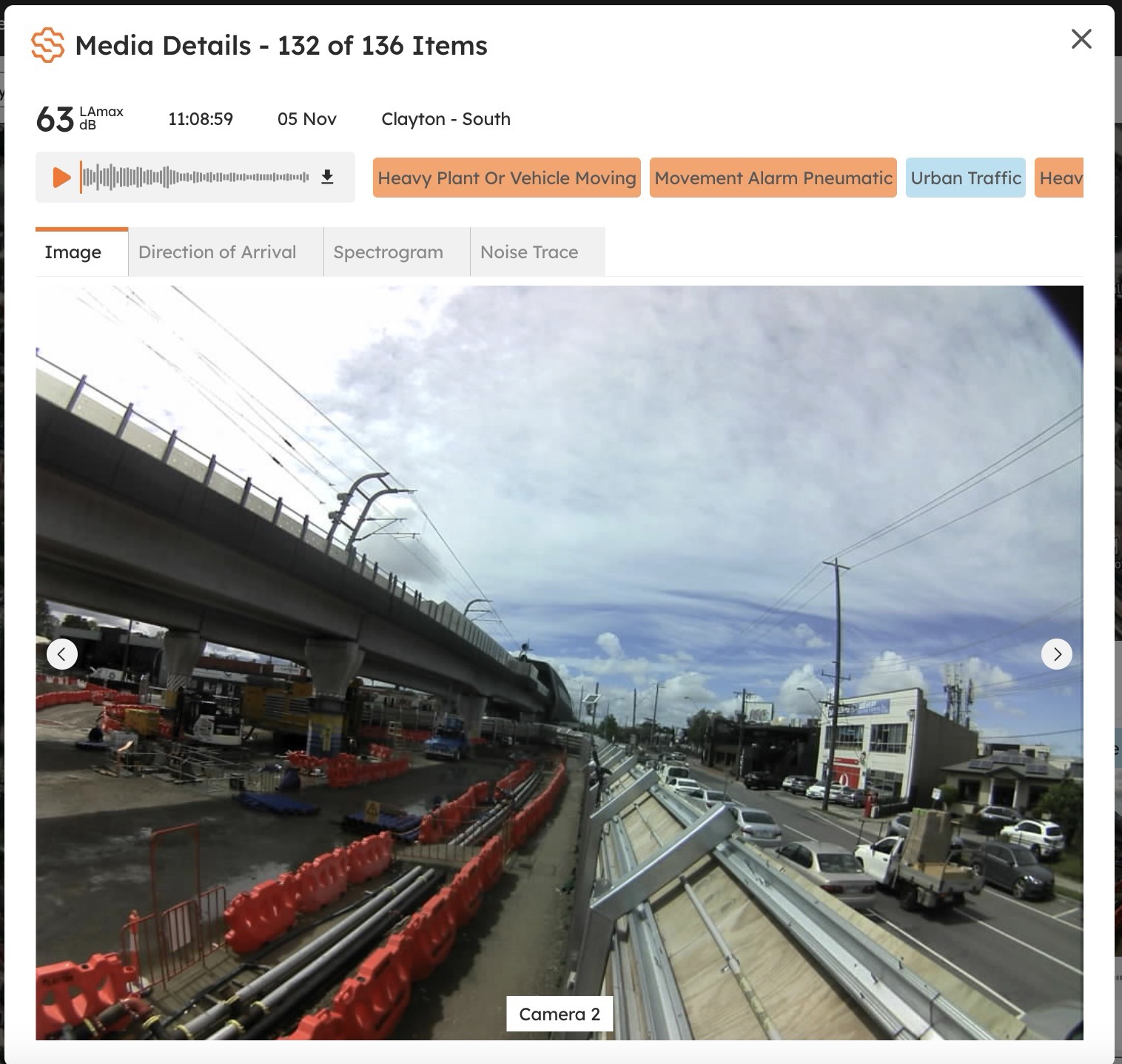SiteHive Hexanode Noise
The SiteHive Hexanode Noise Device gives you continuous, real-time measurement of sound levels — helping you not just capture data, but understand where noise is coming from and how it changes over time.
It’s designed for easy deployment, reliable performance, and smart insights

Next-gen Hexanode Noise devices are accurate, reliable, and adaptable.
Capture real-time noise levels, including LAeq, LAmax, LA10 and LA90 - with precision in all environmental conditions.
Event-triggered images, audio, and DoA mapping give you full visibility.
Can be used standalone or paired with noise monitoring.
Remote updates and connectivity ensure consistent, high-quality data.
NATA Calibration for trusted compliance
Real-time noise data
The SiteHive Hexanode Noise Device continuously captures and analyses sound, providing real-time data on all key acoustic parameters - so you can identify issues immediately and manage noise impacts effectively.

Here’s what each parameter means:
LAeq – The equivalent continuous sound level. It represents the average noise level over a set period (15 minutes in the above example) and is the main measure used to assess environmental noise compliance.
LAmax – The maximum recorded noise level during the measurement period. It helps identify peak events, such as heavy-vehicle passes or sudden impacts.
LA10 – The level exceeded 10% of the time, often used to describe traffic or intermittent noise.
LA90 – The level exceeded 90% of the time, typically representing the background noise level.
LAmin – The minimum noise level recorded, showing the quietest conditions.
All of these parameters are calculated automatically by the Hexanode in real time, so you always have clear, accurate insight into what’s happening on site - as it happens.
NATA Calibration
The Next Generation SiteHive Hexanode Noise and Noise+Dust Devices are now available with NATA-accredited calibration, providing the highest level of confidence in your noise data.
All calibrations are traceable, documented, and aligned with Australian national standards, ensuring your monitoring meets industry and regulatory requirements.
Each device is calibrated in a NATA-accredited laboratory, verified against international standards:
IEC 61672-3:2013 — Sound Level Meters
IEC 61260-1:2019 — Octave Filters
Your calibration certificate confirms full traceability and compliance, so you can rely on your data for EPA reporting, compliance monitoring, and detailed site assessments.
How to access NATA-level calibrated devices
You can:
Have your SiteHive devices calibrated yourself by any NATA-accredited lab; or
SiteHive can provide you with NATA-calibrated devices and certification. This service is $50/month per device, and SiteHive manages the full calibration process so your devices arrive fully calibrated with certificates.
(Note that the next-generation devices can also be used without NATA calibration – they come as standard with calibration conducted by SiteHive.)
Audio and image capture
Capture more than just numbers. With event-triggered images and audio, the SiteHive Hexanode records what’s happening when a noise event occurs - giving you clear context and actionable insight.

Automatic media capture: As soon as an event is triggered, the device captures a time-stamped image and a 6-second audio clip (3 seconds before and 3 seconds during the event), enabling fast and accurate identification of the source and nature of noise.
AI-classified audio labels (Enviro Pro): Each audio clip is automatically analysed and labelled (e.g., “works-related”, “traffic”, “background”) so you can quickly filter and prioritise what matters most.

ℹ️ Important note on media triggers: Media (image and audio captures) are based on LAmax – the peak noise level – and not the same thresholds you set up for your rules (which may use LAeq or other metrics). This means that while a rule may trigger at one level, the media capture may follow a different criterion aligned to peak levels. (How to set up media triggers)
DoA (Direction of Arrival) Mapping
Identify exactly where noise is coming from, visualised directly on the SiteHive Dashboard.

The SiteHive Hexanode Noise Device uses a multi-microphone array to detect the Direction of Arrival (DoA) - the precise angle from which sound originates.
By analysing the tiny differences in when each microphone receives a sound wave, the device accurately determines the direction of the noise source.
You can see DoA data directly on your SiteHive Dashboard:
Dashboard Map: The map displays arrows and directional indicators showing where the loudest noise activity is coming from.
DoA Visualisation: When you click on a monitoring point, a detailed circular chart appears showing the distribution of noise by direction over your selected timeframe.
Integrated Analysis: Combine this with Event Data, Audio and Images to quickly identify the likely source of an exceedance.
Together, these tools provide a clear, visual understanding of both noise levels and their direction, helping you to explain what’s happening on site and respond appropriately.
